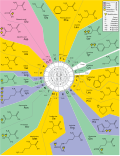Genetic code

The genetic code is the set of rules by which information encoded within genetic material (DNA or mRNA sequences) is translated into proteins by living cells. Biological decoding is done by the ribosome. This links amino acids together in an order specified by mRNA. It uses transfer RNA (tRNA) molecules to carry amino acids and to read the mRNA. The molecules read the mRNA three nucleotides at a time. These nucleotide triplets are called codons. A codon specifies which amino acid will be added next during protein synthesis. There are some exceptions,[1] but usually a three-nucleotide codon represents a single amino acid.
The genetic code among all organisms is very similar. It can be expressed in a simple table with 64 entries.[2]
The genetic code decides the protein sequence for a given coding region (gene). Other regions in the genome can influence when and where these proteins are produced.
Genetic Code Media
A series of codons in part of a messenger RNA (mRNA) molecule. Each codon consists of three nucleotides, usually corresponding to a single amino acid. The nucleotides are abbreviated with the letters A, U, G and C. This is mRNA, which uses U (uracil). DNA uses T (thymine) instead. This mRNA molecule will instruct a ribosome to synthesize a protein according to this code.
Examples of notable mutations that can occur in humans
Axes 1, 2, 3 are the first, second, and third positions in the codon. The 20 amino acids and stop codons (X) are shown in single letter code.
Related pages
References
- ↑ Turanov A.A. et al 2009 (2009). "Genetic code supports targeted insertion of two amino acids by one codon". Science. 323 (5911): 259–61. doi:10.1126/science.1164748. PMC 3088105. PMID 19131629.
- ↑ Nakamoto T. 2009 (2009). "Evolution and the universality of the mechanism of initiation of protein synthesis". Gene. 432 (1–2): 1–6. doi:10.1016/j.gene.2008.11.001. PMID 19056476.




